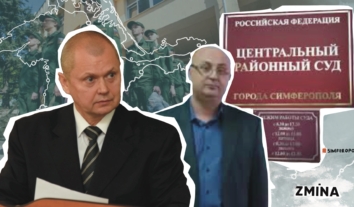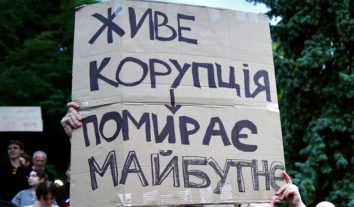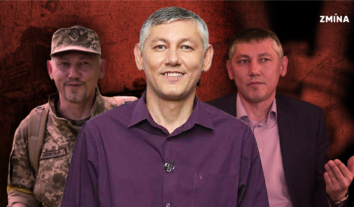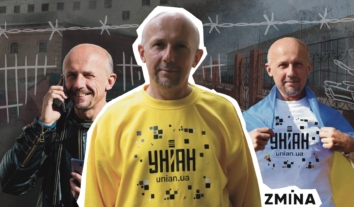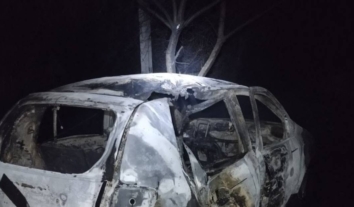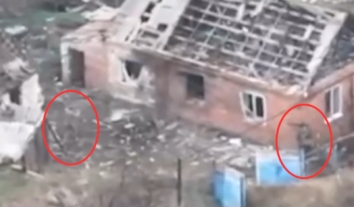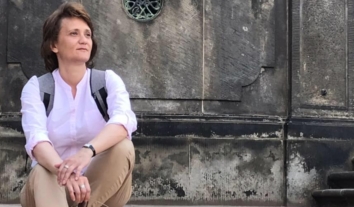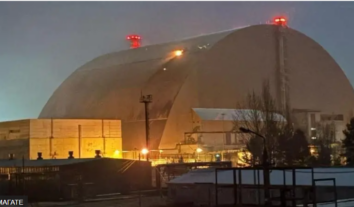“Mariupol is a pattern of Russian warfare” – how Russia destroyed the city
Mariupol, with a population of around 600,000 before February 2022, is a city in the Donetsk region known for its steel industry with access to the Azov Sea. During the first weeks of the full-scale invasion, Russian occupying forces used typical Russian war tactics to siege the city, namely, the destruction and total devastation of settlements with the extermination of tens of thousands of civilians. For example, they have already used such methods in Grozny, Chechnya, in the late 1990s or Aleppo, Syria, in 2016.
The Russian military deliberately destroyed civilian infrastructure, attacked places where civilians were hiding, and did everything possible to prevent residents from escaping to Ukrainian-controlled territory.
Almost immediately after the complete occupation of the city in spring 2022, the Russians began destroying evidence of their crimes. However, Russian tactics in the first few weeks of its occupation of Mariupol were documented, primarily thanks to people who managed to leave the city.
Researchers from the Ukrainian human rights organization Truth Hounds and the international organizations Human Rights Watch and SITU Research interviewed more than 200 people who were directly in Mariupol during the capture and occupation of the city. They also analyzed 850 photographs and videos taken between February 24, 2022, and June 17, 2023. This allowed them to recreate the events in the city and conduct a preliminary analysis of how the Russians destroyed Mariupol.
ZMINA recounts the main points from the study “Our City Was Gone.” Russia’s Devastation of Mariupol, Ukraine.”
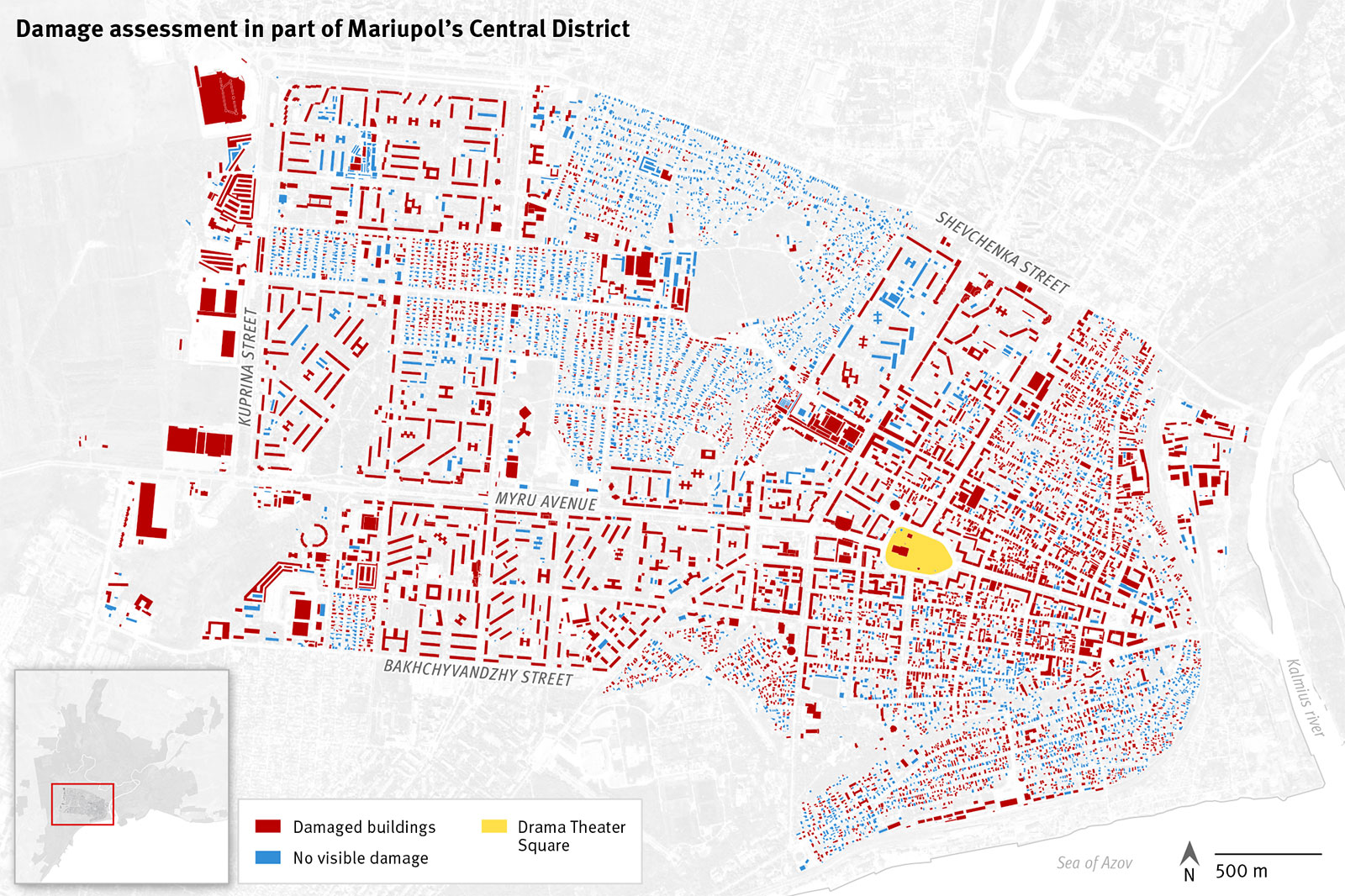 Illustration from the report
Illustration from the reportDestruction of infrastructure and homes
Russians attacked Mariupol from many directions on February 24, 2022. By March 1, the researchers say about half of the city’s power grids were out of service, most likely due to damage to power lines and poles caused by the fighting.
On the morning of March 2, electricity went out at a key filtration station, leaving the entire city without water. Without a water supply, the city’s heating system failed, and it was still freezing outside.
On the same day, Russian forces shelled part of the Azov-220 transformer station, which powered substations in the city’s Central and Kalmius districts. Analysts speculate that the Russians deliberately targeted the station to cut off power throughout the city entirely.
Residents had to come out of shelters and stand under fire in line to fetch water, for example, or cook over an open fire. To wash and sometimes drink, people collected rainwater and melted snow.
Due to the constant shelling of residential areas of the city, there were many wounded civilians, and they were mainly unable to receive medical care.
The fighting damaged all 19 hospital complexes in the city, making it sometimes impossible to reach them. Volunteer Mykhailo Puryshev, who was in Mariupol and helped the locals, notes that there were problems with medicines.
The researchers emphasize that in most cases, it remains uncertain what caused the infrastructure damage in a particular case.
For example, electricity infrastructure can be a legitimate military objective under certain conditions. If one side uses this facility for military purposes, the other side can attack it, but only if it provides a “clear military advantage ” and does not have an excessive impact on the civilian population. This is the principle of proportionality in warfare, but the Russian command and army seem to disregard it altogether.
At about three in the afternoon on March 11, 2022, a Russian aircraft bomb fell on a multi-story residential building at 98 Mytropolytska Street in the city’s central district.
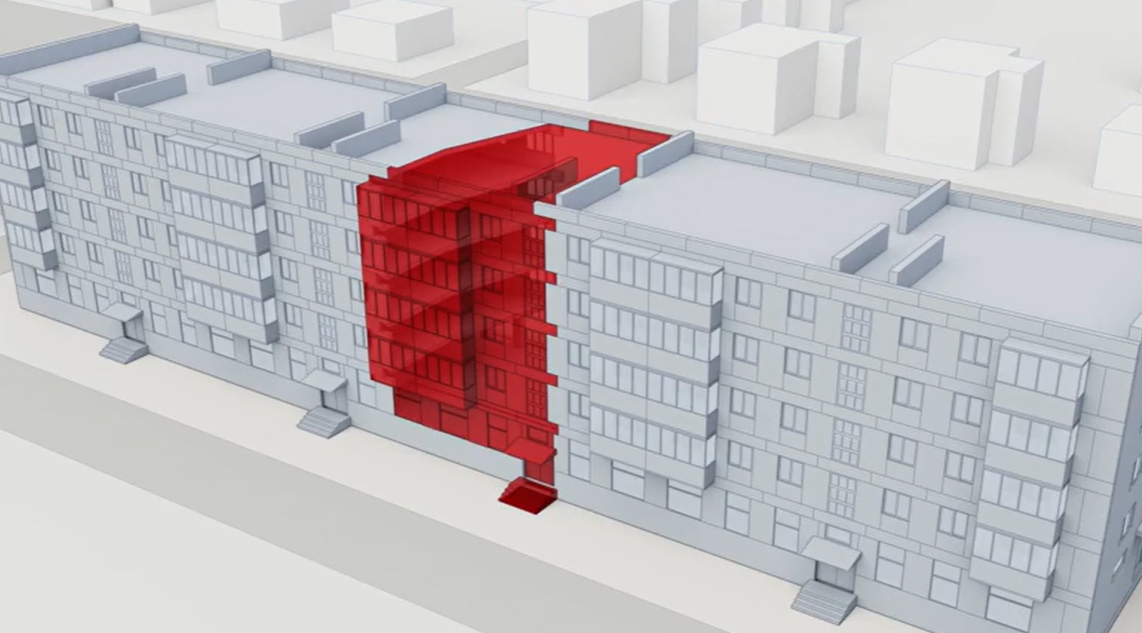 Reconstruction of the damaged part of the building at 98 Metropolytska Street
Reconstruction of the damaged part of the building at 98 Metropolytska StreetThe third entrance completely collapsed. Some people were trapped under the rubble in the building itself, others in front of the entrance. They usually cooked food there. According to one of the men, who was later ordered to dismantle the rubble and collect body fragments, the pile of debris was about 25 meters wide.
The survivors were trapped: the fire engulfed part of the building, and firefighters tried to extinguish the fire, but the Russians kept shelling the area, so the rescuers had to leave.
The researchers analyzed 14 square kilometers of the Drama Theater area in total. According to their estimates, 93% of high-rise buildings and almost half of one-story buildings were damaged.
Siege of the city
In the first days of the full-scale invasion, thousands of people left Mariupol, and in a couple of days, about 450,000 residents remained in the city.
Witnesses recall that people at the time mostly thought that Russia’s attack would be short-lived and that, like in 2014, the city would remain free and mostly intact.
“Everyone thought that the attacks would be limited to small-scale shelling of the suburbs, so we ignored the information about evacuation trains. No one could have imagined the horrors that would ensue,” recalls one of the respondents.
The Russians kept the city surrounded for seven weeks. From March 1 to March 13, almost no one was able to leave the city, as Russian troops and armed groups under their control blocked all roads and intensified shelling.
The Ukrainian authorities regularly reported attempts to establish green corridors for trucks carrying humanitarian aid to the city and evacuation buses, but negotiations with Russian forces were largely unsuccessful. The local authorities wanted to use about a hundred buses from the city’s fleet to evacuate people. However, starting on March 4, the bus depot was constantly shelled, and many vehicles were damaged.
There were also attempts to organize corridors for private vehicle convoys. On March 14, the UN Monitoring Mission reported that a convoy of personal vehicles and people on foot left Mariupol for Zaporizhzhia.
Between March 14 and March 31, Zaporizhzhia authorities registered nearly 60,000 people who left Mariupol and nearby settlements by private car. On April 30, a humanitarian corridor to the government-controlled areas was opened, allowing more people, primarily women and children, to leave.
One of the interviewed residents of Mariupol recalls that at the evacuation points, the Russian military filmed those who were there and warned them over a loudspeaker about a missile attack that would happen during the evacuation.
By May, about 150,000 people remained in Mariupol. They lived in terrible conditions: without electricity, water, and heating, and mostly without mobile communication and information about what was happening in their city and the country. Essential services began to be restored only in the second half of 2022.
People were forced to spend most of their time in basements and other shelters. Residents also gathered in large groups in the shelters of hospitals and other non-residential buildings. At first, the Mariupol city authorities delivered aid to some of these places.
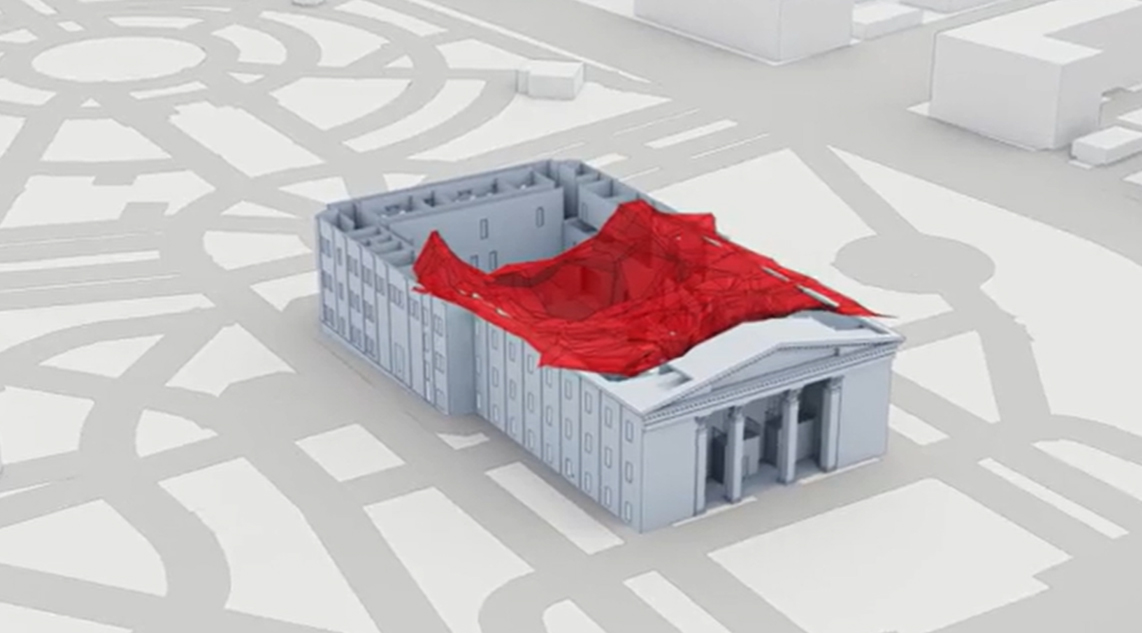 Reconstruction of the damaged building of the Drama Theater
Reconstruction of the damaged building of the Drama TheaterBecause of the siege, it was impossible to deliver even food to the city. The population lived mainly from their stocks and what was distributed by volunteers. In addition, people were forced to move around the city under fire to find food.
Subsequently, the Russians set up a system to filter everyone who wanted to leave the city. They interrogated people, checked their phones and other gadgets, and forced them to log into their social media accounts and read their correspondence.
Some people were detained by the Russians during the filtration process, especially people with pro-Ukrainian views.
Today, the Russian authorities are doing everything possible to assimilate the population of Mariupol as quickly as possible and allegedly turn them into Russians. At least formally.
According to media reports, the occupation administration of Mariupol, like in other occupied cities, is imposing Russian passports on residents. This, in particular, is a prerequisite for working in the public sector: in educational or medical institutions, for example. According to interviewed residents of Mariupol, a Russian document is also required to do business, receive a pension, or apply for compensation or repair of damaged housing.
Russia is also investing significant efforts in cultural and educational occupations. In urban schools, education has resumed in Russian. Only teachers who have been retrained according to Russian standards teach there. Curricula have also been changed to Russian. For example, the history materials for the 11th grade refer to events, including those of 2014. The textbook portrays Ukraine as a “Nazi state” and Russia as a victor and liberator.
Killed and Injured
During the siege, Russian assaults, and subsequent occupation, thousands of civilians were killed or died due to difficult circumstances. But it isn’t easy to give even a rough estimate.
The Russians almost immediately began destroying evidence of their crimes, reburying bodies, and confusing everyone around them. Witnesses of those events who remain in the city are under constant threat of reprisals, so they mostly do not share their memories of their experiences.
Some people were killed or injured as a direct result of the hostilities. Others, especially the elderly and children, died from chronic diseases, lack of medical care, and inhumane living conditions.
In the early days of the fighting, the city authorities managed to collect some of the bodies lying on the streets and deliver them to morgues. However, this became increasingly difficult and dangerous because of the shelling.
People who died during the siege were often buried in shallow graves in yards and parks nearby, as it was almost impossible to get to morgues or hospitals due to the fighting and constant shelling. For example, one of the interviewees told about 11 buried people in the yard of his house at 189 Budivelnykiv Avenue. Another witness said that there were graves of about 20 people in the yard of a nine-story building on Troitska Street.
In early April of 2022, Russia established permanent control over the city. At the same time, they began removing bodies from the streets, exhuming graves in the city, and clearing rubble. The bodies were taken to a makeshift morgue on the western outskirts of the city. It was set up in a former fruit and vegetable warehouse at 23 Zaporizhske Shosse, about half a kilometer from the Metro shopping center. The bodies found under the rubble of the building at 98 Mytropolytska Street were brought there.
That April, the occupation forces announced that they had created a database of the dead so that relatives could find them. One of the interviewed residents recalls that the database was stored on a single laptop on the ground floor of a building near the morgue. There was always a long line to see it, and groups of 10 people were allowed to view it. The woman says that her family asked for online access to the database, but they were denied.
At the same time, according to the witness, this database was not updated from May 18 to mid-September.
Some of the bodies were left under the rubble of the buildings. Analysts say that the Russians probably destroyed these remains and took them away with the wreckage when they demolished the damaged structures. They have never been identified.
At the same time, based on satellite imagery and publicly available photos and videos, the researchers established that at least 10,284 people were buried in the five largest cemeteries in the city and its surroundings between March 2022 and February 2023. Experts suggest that 8034 may have died as a result of the fighting and siege.
The witnesses interviewed by the researchers were able to recall a total of 661 dead people. Some of them were familiar to them, and some of them saw the bodies in the city but could not identify them.
According to the Ukrainian authorities, between February 24, 2022, and July 28, 2023, 9,016 missing persons were registered in Mariupol. Almost 4,000 of them are likely civilians—relatives of the missing fear that they will never be able to find their remains.
Culprits
The analysts studied a wide range of open sources. They reconstructed the vertical of Russian troops and units involved in the capture and siege of Mariupol from late February to early May 2022.
In addition, they managed to identify 10 Russian commanders and high-ranking officials, including President Vladimir Putin, who are directly responsible for the actions of Russian forces in the city.
At the same time, the researchers note significant gaps in their scheme of military hierarchy. This is partly because there was no single command over Russian troops during the first phase of the full-scale invasion. There is also a lack of data to link specific attacks to the units responsible for them.
The forces that participated in the attack on Mariupol were organized under the command of the Southern Military District, which General Alexander Dvornikov then headed.
Human Rights Watch experts identified in Mariupol the 8th Combined Arms Army, including units of the 68th Tank Regiment of the 150th Motorized Rifle Division and the 102nd Motorized Rifle Regiment, as well as two land units of the Black Sea Fleet – the 810th Separate Marine Brigade and the 382nd Separate Marine Battalion.
In addition, there were units of two special forces brigades in Mariupol that are subordinated to the Main Intelligence Directorate of the Russian General Staff: The 22nd Separate Special Forces Brigade and the 346th Separate Special Forces Brigade, as well as police units of the Chechen Interior Ministry.
The Russian military leadership also sent units formed from residents of the previously occupied territories to capture Mariupol. In particular, analysts identified several units of the 1st Army Corps of the so-called “Donetsk People’s Republic (DPR),” which could have been subordinated to the 8th Combined Arms Army at the time. The “Vostok Battalion,” the 1st Separate Somali Tank Battalion, the 107th Rifle Regiment, the 9th Separate Marine Regiment, and the Cascade Operational and Combat Tactical Formation were present in Mariupol.
The military of all these units could have been direct perpetrators of war crimes in Mariupol. Responsibility for the command may lie with ten people: Vladimir Putin, President of the Russian Federation and Supreme Commander-in-Chief of the Armed Forces; Sergei Shoigu, Defense Minister; Valery Gerasimov, First Deputy Defense Minister and Chief of the General Staff of the Armed Forces; Sergei Rudskoy, First Deputy Chief of the General Staff of the Armed Forces and Chief of the Main Operational Directorate of the General Staff of the Armed Forces; Alexander Dvornikov, then Commander of the Southern Military District; Viktor Zolotov, Commander-in-Chief of the National Guard of the Russian Federation; Andrey Mordvichev, Commander of the 8th Combined Arms Army; Ramzan Kadyrov, head of the Chechen Republic and the Chechen National Guard; Adam Delimkhanov, Commander of Chechen troops in Mariupol; and Denis Pushilin, head of the so-called “DPR” and Commander-in-Chief of the Armed Forces of the “DPR.”
The researchers emphasized that these commanders and leaders from the other 17 units identified in Mariupol should be investigated and held accountable for their actions.

